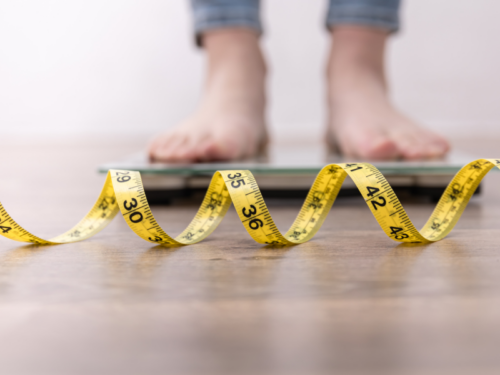
Table of Contents
The Difference Between Disordered Eating and Eating Disorders, According to Therapists

Written By: Sarah Fielding

Clinically Reviewed By: Erin Husting
May 9, 2025
6 min.
Learn about the difference between disordered eating and eating disorder symptoms.
Learn more about our Clinical Review Process
Table of Contents
Food is one of the key things that sustains human beings. It provides nutrients, energy, and, often, enjoyment. Yet, it’s also a form of stress or a method of control for many people. In some cases, these adverse feelings and experiences stem from eating disorders.
According to a report from Harvard, the Academy for Eating Disorders (AED), and Deloitte Access Economics, nearly 1 in 10 Americans (9%) will experience an eating disorder in their lifetime. That percentage amounts to about 28.8 million Americans. Eating disorders also cause 10,200 deaths annually, about one every 52 minutes.
However, there is also something known as disordered eating, which comes with its own symptoms and thought processes. So, what is the difference between disordered eating and eating disorders? Below, we break down what disordered eating and eating disorders look like, as well as treatment options for each.

Virtual intensive treatment to heal your relationship with food and your body
We offer specialized curriculum and support, where available, for people struggling with eating disorders.
What is disordered eating?
“Disordered eating involves irregular or emotionally driven habits — like skipping meals, guilt after eating, or rigid food rules — that don’t occur often enough to meet clinical criteria but still affect well-being,” says Charlie Health Group Facilitator Bree Williams, LPCA. “Eating disorders are diagnosable mental health conditions involving extreme, ongoing behaviors like restriction, binging, or purging that significantly disrupt daily life and can cause serious medical issues.”
Unlike eating disorders, which have set diagnostic criteria, disordered eating can look a lot of ways. “Disordered eating refers to a range of abnormal eating behaviors that may not always meet the criteria for an eating disorder but can still be harmful to one’s physical and emotional well-being,” says Charlie Health Group Facilitator Chris Hinton, MS, M.Ed., LPC, CLC, CTP. The key is to look at the symptoms and how these actions impact the individual.
Only a certified medical professional can determine whether someone is experiencing disordered eating or an eating disorder. That being said, knowing the symptoms of each can help you and your loved ones understand if there might be an issue and reach out for care sooner.
Common symptoms of disordered eating
As Williams puts it, “Disordered eating exists on a spectrum” of behaviors. According to Williams and Charlie Health Contemplative Practitioner Tairesha “Sunflower” Flemister, LMSW, disordered eating habits include:
- Frequently skipping meals
- Obsessively counting calories
- Focusing on just “clean” eating
- Enforcing rigid food rules, like not eating carbs after a certain time
- Having weight fluctuation due to restriction and binging
- Using exercise as a punishment for eating
- Eating when emotional
- Feeling guilt or shame around eating
- Sneaking food in secret
- Feeling anxious about eating around other people
Disordered behaviors have also been normalized as part of losing weight and thus are often overlooked. “Disordered eating often flies under the radar because these behaviors are normalized in diet culture or mistaken for ‘discipline,’” Williams adds. “But when food and body thoughts dominate your life, it’s a red flag,” Flemister adds to that, warning that disordered eating can become an eating disorder if left alone.
What are eating disorders?
So, with that said, what exactly is an eating disorder? According to Flemister, “Eating disorders are clinically diagnosable mental health conditions characterized by severe disturbances in eating behaviors and related thoughts and emotions.”
There are a few different types of diagnosable eating disorders. According to the American Psychiatric Association, these are the main types of eating disorders and their symptoms.
1. Anorexia
Anorexia, also known as anorexia nervosa, is an eating disorder in which someone significantly restricts their food intake to the point of starving themself. This behavior is typically driven by an immense fear of gaining any weight or appearing fat. In some cases, a person living with anorexia will binge and purge. Anorexia symptoms include:
- Dizziness
- Dehydration
- Intolerance to cold
- Muscle weakness
- Brittle hair and nails
- No menstrual period
- Heartburn
- Severe constipation and bloating after meals
- Stress fractures
- Anxiety, depression, and irritability
2. Bulimia
Bulimia, also known as bulimia nervosa, is an eating disorder characterized by jumping between eating very low-calorie foods and quickly eating a large amount of high-calorie foods. These instances occur at least weekly and are followed by fasting, compulsive exercise, using laxatives, or vomiting. A person living with bulimia can be any size and will often hide their symptoms, making it harder for other people to notice. Bulimia symptoms include:
- Dizziness
- Continual sore throat
- Frequently going to the bathroom after meals
- Swollen salivary glands
- Heartburn and reflux
- Dental decay
- Misuse of diuretics
- Large quantities of food quickly disappearing
3. Binge eating disorder
Binge eating disorder is similar to bulimia in that a person will binge eat. However, they do not typically take measures to counteract the binge, such as fasting or vomiting. A person living with binge eating disorder will binge eat at least once a week for three months and feel out of control.
They must also have three or more of the following symptoms:
- Eating faster than normal
- Eating until too full
- Eating a large quantity of food even when not hungry
- Eating alone due to embarrassment about the amount of food consumed
- Feeling disgust toward themselves, depressed, or guilty
There is also a category called specified feeding and eating disorder, which comprises eating disorders and other issues that might not exactly fit into one of the above disorders.

Disordered eating vs eating disorder treatment
Like any physical or mental health condition, the right combination of treatments will depend on the individual’s circumstances. In the case of disordered eating, it really depends on what a person’s symptoms are and what might be triggering the behavior.
1. Disordered eating treatment
Hinton notes that, in some cases, a person can treat disordered eating by changing their eating habits, working on self-awareness, and leaning on loved ones. However, it can also involve more intensive treatment, such as therapy or support groups.
“Treatment for disordered eating often involves support from registered dietitians, therapists, or counselors with experience in intuitive eating and body image work,” says Flemister. “Peer support groups may provide accountability and community. Treatment may include building healthier food relationships, addressing emotional triggers, and unlearning harmful beliefs about weight and worth.”
2. Eating disorder treatment
Eating disorder treatment is typically a more expansive, longer process. “Treatment typically requires multidisciplinary treatment, including therapy, nutrition counseling, medical monitoring, and possibly hospitalization for serious cases,” says Hinton. Therapeutic techniques can include cognitive behavioral therapy and dialectical behavior therapy, and dig into the psychological root of the eating disorder. It can take some time to reach eating disorder recovery, but having the right team around you — both medically and socially — can make a big difference.
“Early intervention is key for both disordered eating and eating disorders,” adds Flemister. “Regardless of diagnosis, anyone struggling with food and body image deserves support and healing.”

How Charlie Health can help
If you or a loved one is struggling with disordered eating or an eating disorder, Charlie Health is here to help. Charlie Health’s virtual Intensive Outpatient Program (IOP) provides more than once-weekly mental health treatment for dealing with serious mental health conditions. Our expert clinicians incorporate evidence-based therapies into individual counseling, family therapy, and group sessions. With treatment, managing your mental health is possible. Fill out the form below or give us a call to start healing today.
References
https://www.psychiatry.org/patients-families/eating-disorders/what-are-eating-disorders




